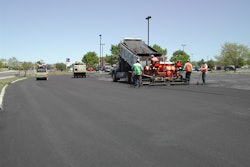
Shorter passes, parking lot islands with shrubbery, rock retention walls on a driveway, these are unique to a property but have their added challenges when it comes to commercial or residential paving. Brian Hall, territory manager for LeeBoy explains best practices, proper operation of the paver and techniques to improve the quality of your work stating that "quality paving starts with proper planning."
Even though each job is different, keep in mind these best practices to deliver a quality mat and desired results for each customer.
Schedule a Pre-Job Meeting
Take the time with your crew to discuss the job, assign tasks to each team member and ensure everyone understands the scope of work. During this meeting, make sure to cover work zone safety and explain the importance of:
- Proper clothing - long pants, work boots, gloves, sunscreen, hard hats and safety vests
- Don't walk between truck and paver
- Don't talk on cellphone while operating the paver
- Locate and read all safety decals on the machine
- Use common sense
These are all good reminders, especially if you have new members or if your team has been off for the winter season. "Emphasize to your crew members that they are important to the success of the job," said Hall. "This will instill ownership thinking and create a sense of pride in the work they complete."
Daily Inspection on All Equipment
A complete inspection is an important preventive way to make sure equipment is safe for use and that all systems and components are working properly. You can make your own checklist or consult with the equipment manufacturer.
- Have your operators read and understand the manual as well as all instruction and safety decals
- Check engine, transmission and hydraulic oil levels. Fill to the correct level as necessary
- Visually inspect the entire machine including tires for wear, hydraulic hoses for leaks, electrical wires, pedal and levers, protective devices, shields and seat belt for wear or damage
Order Tons Not Truckloads
Planning for you project might seem overwhelming or you might not be sure where to start. Communication is key to the success of the project. Make sure you are talking with your crew members, plant operator and truck drivers to ensure everyone is on the same page.
"Keep in mind the length of haul and traffic conditions the trucks are in," said Hall. "Keeping the communication line open will help you avoid stop and go paving and reduce the potential of failures."
If you do have to stop the paver, Hall advises leaving the hoper 25% full, keeping the asphalt at the bottom warm. When the truck shows up, the HMA will reinvigorate the top layer of the asphalt in the paver.
Site Preparation and Layout
Physically checking the pavement for imperfections is imperative. Look for things like standing water and cracking. "Any old cracks in the existing surface will propagate to the new surface over time," said Hall. "Crack filling will stop the reflective cracking or route the crack if you have the equipment because that will give you a tighter seal."
Make sure the pavement has been cleaned properly with blowers, brooms or a sweeper before laying the fresh mat. "Give yourself the best chance to succeed," said Hall.
Take time to set up the layout of the job is equally important. Utilizing technology such as grade control equipment or string/paint lines can optimize success. Also, remember other key factors such as:
- Fewest number of tie-ins
- Truck entrance and exit
- Pave your way out
- Keep your roller busy
The Screed is the Money Maker
Hall described the paver as two machines, "the front part with the engine is the workhorse and the screed is the money maker." The screed is crucial for both the quality and density of an asphalt mat. With this in mind, equipment owners need to make sure their screed is properly maintained in order to ensure the quality of the pavement.
Read Next: How to Properly Maintain Your Screed
Check and adjust flight screws, extensions and crown. "Zero out" electric screws, set up and check automatic grade controls, set end gates to meet job requirements and always spray the screed before lighting burners.
"Remember that the screed needs time to react to the change in angle," said Hall. "When you adjust the screed give yourself five tow arms to see the change, don't be a willmill Johnny. Let that screed work for you."
The Finishing Touches
It is important to end the day the way it started, with a maintenance routine. Proper cleaning and maintenance will prolong the life of your equipment and reduce downtime or wasted labor wages.
- Remove excess asphalt from the paver
- Clean and spray components like auger and conveyor chains
- Run conveyors and spray with release agent
- Add fuel at night
- Grease necessary parts
All manufacturers have preventive maintenance guidelines, so reference that for any questions that may arise. "This is the life of your machine and the livelihood of your company," added Hall.












![Lee Boy Facility 2025 17 Use[16]](https://img.forconstructionpros.com/mindful/acbm/workspaces/default/uploads/2025/09/leeboy-facility-2025-17-use16.AbONDzEzbV.jpg?ar=16%3A9&auto=format%2Ccompress&fit=crop&h=135&q=70&w=240)








